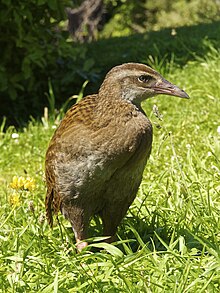Weka
| Weka | |
|---|---|
 |
|
| In the South Island, New Zealand | |
| Scientific classification | |
| Kingdom: | Animalia |
| Phylum: | Chordata |
| Class: | Aves |
| Order: | Gruiformes |
| Family: | Rallidae |
| Genus: | Gallirallus |
| Species: | G. australis |
| Binomial name | |
|
Gallirallus australis (Sparrman, 1786) |
|
The weka (also known as Maori hen or woodhen) (Gallirallus australis) is a flightless bird species of the rail family. It is endemic to New Zealand, where four subspecies are recognized. Weka are sturdy brown birds, about the size of a chicken. As omnivores, they feed mainly on invertebrates and fruit. Weka usually lay eggs between August and January; both sexes help to incubate.
Weka are large rails. They are predominantly rich brown mottled with black and grey; the brown shade varies from pale to dark depending on subspecies. The male is the larger sex at 50–60 cm (20–24 in) in length and 532–1,605 g (1.173–3.538 lb) in weight. Females measure 46–50 cm (18–20 in) in length and weigh 350–1,035 g (0.772–2.282 lb). The reduced wingspan ranges from 50 to 60 cm (20 to 24 in).
The relatively large, reddish-brown beak is about 5 cm (2.0 in) long, stout and tapered, and used as a weapon. The pointed tail is near-constantly being flicked, a sign of unease characteristic of the rail family. Weka have sturdy legs and reduced wings.
The common name, "weka", is a Māori word. The species was named Rallus australis by Anders Erikson Sparrman in 1789. Sparrman published the information in Museum Carlsonianum, four fascicules based on specimens collected while voyaging with Captain James Cook between 1772 and 1775.Australis is Latin for "southern". Johann Georg Wagler's suggestion of the Ocydromus genus in 1830 to describe each weka as a species was generally adopted. However, weka were later decided as a single species in the Gallirallus genus with four subspecies.
...
Wikipedia

